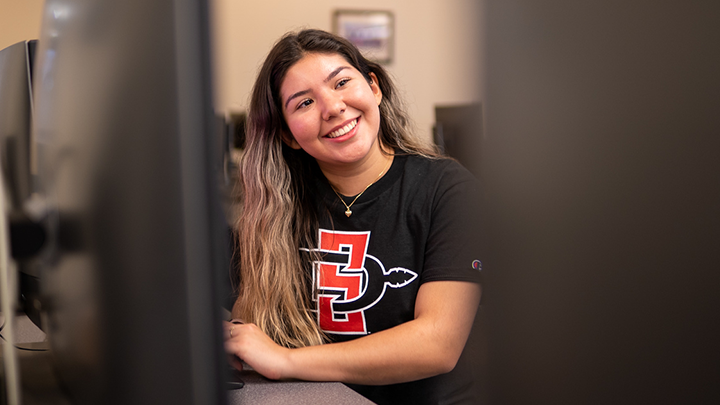SDSU’s Textbook Accessibility Program Achieves Record Participation, Undergoes Rebranding
Equitable Access will be rebranded as Day1Ready this summer. In just two years since the program launched, it has set a new standard for student preparation by ensuring timely access to textbooks and digital materials for a flat rate and has saved students close to $14 million on new printed materials and over $7 million on digital course materials.
The idea behind the new name reflects the enthusiasm and confidence students feel when they’re well-prepared, said Ben Eisenstein, associate director for Aztec Shops, which operates the SDSU Bookstore.
The way the program works is that students are pre-enrolled into the service and charged a flat rate per credit hour. Once a student registers for a course, the textbooks and materials are added to their Canvas account, sometimes up to several days before the class begins.
Hannah Burington, a second-year student majoring in statistics with an emphasis in data science, said her courses require a heavy load of materials. For her, the convenience of early access and companion study aid applications were equally valuable.
“Not only did I have access to the textbooks for all of my classes but it also helped me with some interactive coursework,” she said. “There are other programs I was able to use, like software programming…apps to help me do my homework.”
The program currently serves 80% of all SDSU’s undergrads; meaning approximately 25,000 students have all materials in hand on the first day of class.
First- and second-year students are taking advantage of the program with a combined 90% adoption rate, according to SDSU Bookstore data.
In a survey of the program conducted in fall 2023 by SDSU’s Program Evaluation, Compliance, and Assessment (PECA), a unit of Student Affairs and Campus Diversity, students listed various reasons for participating in the program and 83% stated it was “easier than shopping for textbooks on (their) own.”
Zachary Almaraz, a second-year business finance major, said the program helped him transition to SDSU from high school by taking out the guesswork of locating textbooks and materials. He’s remained enrolled in the program since arriving at SDSU.
“I didn’t have to search for everything that I had to get for my classes,” he said. “As like a first-year student specifically, to jump into something new and not have all of your materials is a little bit scary.”
“It’s a great idea for all incoming students.”
The program presents more than just convenience, Eisenstein said, as the service also alleviates the financial burden of obtaining course materials for some students.
This spring, the program saved undergrad students an average of $154 on new printed materials and $114 on digital resources compared to traditional purchasing methods, according to SDSU Bookstore data. The discount pricing is made possible due to the high baseline number of students participating in the program.
“If the publishers and the bookstore have a better idea of what to expect from the marketplace, they can offer the course materials at a lower price to the student,” said Eisenstein.
Scott Lipscomb, a professor at SDSU’s School of Music and Dance program and member of the university’s Economic Crisis Response Team, acknowledged that the program may benefit some students more than others.
“SDSU is the fifth institution where I’ve been on the faculty and it is without doubt the most proactive at all levels in ensuring that access is available to our students and is as affordable as we could possibly make,” he said.
“It’s all about making college affordable, and the fact that equitable access is not forced upon students, but it’s given to them as an option. So, if this saves you money, here’s one option that you consider. I think that’s just an ideal way for this program to work.”
61% of the student opt outs surveyed said they found their required materials for less money outside of the program.
However, during fall semester of 2023, only 21% of the opt outs surveyed said they acquired at least some of their course materials on or before the first day of class, and 30% reported having access to at least some of their course materials after the first week.
Also, participation in the program dips as students approach their final year at SDSU, the data shows. Seniors made up the smallest group of enrollees with 70% participation.
Eisenstein expects the program to continue to retain more of its pre-enrolled students in the coming years due to mounting support from students. According to PECA’s report, over half of the students surveyed said they’ve already personally endorsed the program.
“We are really glad to see that 60% of students have already recommended the program to others, and I think that’s directly attributable to why the participation rate has grown from 70% to 80% since we launched it,” he said.

